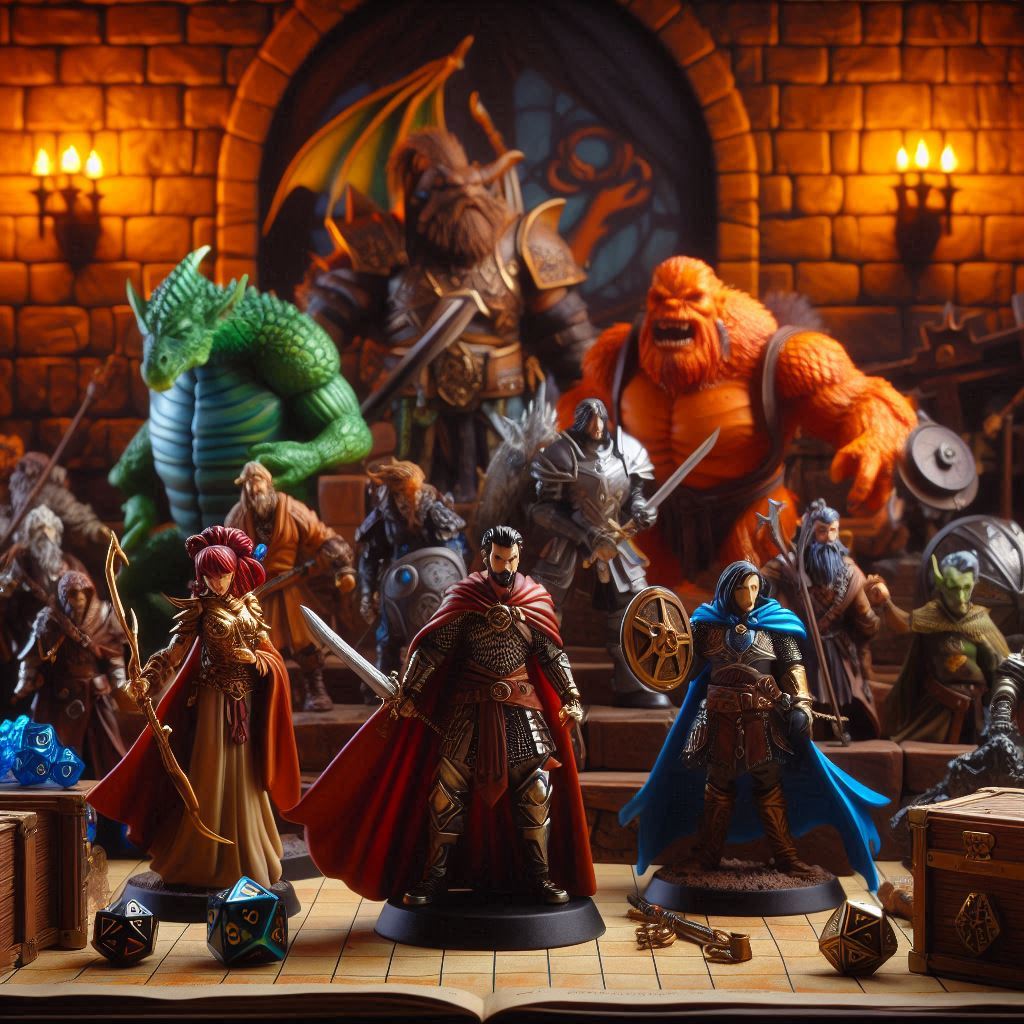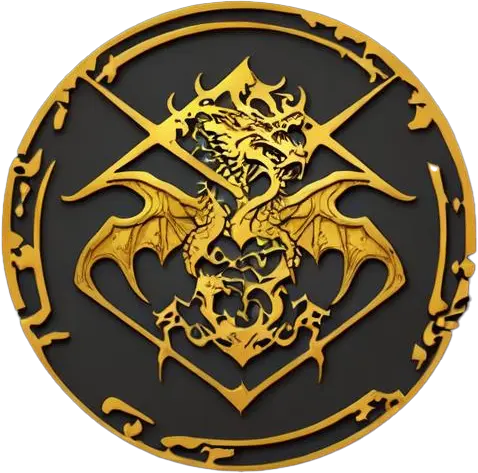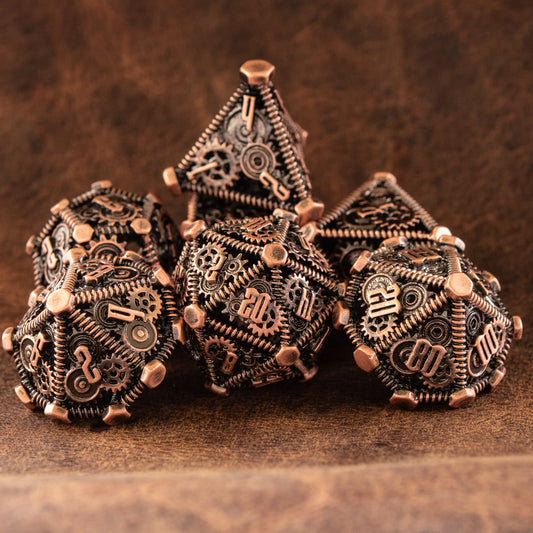
The Spellbinding World of Dungeons & Dragons Dice: A Complete Guide for Adventurers
Share
“Roll for Initiative!”—The Magic Behind Dungeons & Dragons Dice
In the dim glow of candlelight, your party stands at the edge of an ancient dungeon. The rogue checks for traps, the wizard consults their spellbook, and the barbarian grins, tightening their grip on a massive axe. The stakes are high. Your Dungeon Master calls out: “Roll for initiative!”

The room goes silent except for the familiar clatter of dice—a sound that every Dungeons & Dragons (D&D) player knows and loves. That roll determines everything: success, failure, glory, or doom. At that moment, you realize just how much power is held in these little polyhedral treasures.
But what exactly are D&D dice? Why do they come in such bizarre shapes, and how can choosing the perfect set enhance your roleplaying experience? Whether you’re a curious beginner or a seasoned adventurer, this deep dive into the enchanting world of Dungeons & Dragons dice will leave you rolling with excitement. Let’s explore their history, science, artistry, and how they bring stories to life.
Chapter 1: The Origin Story of D&D Dice
From Ancient Knucklebones to Modern Polyhedrals
Dice have been part of human culture for over 5,000 years, originating as knucklebones—small objects made from animal joints. Ancient civilizations, like the Egyptians and Romans, carved dice from wood, bone, or ivory for use in games, gambling, and even divination.
Fast forward to the 1970s: Gary Gygax and Dave Arneson revolutionized tabletop gaming with the creation of Dungeons & Dragons. Their ruleset required more variety than traditional six-sided dice could offer. They turned to the mathematical perfection of Platonic solids, introducing the now-iconic D20, D12, D10, D8, D6, and D4 to players worldwide.
The Rise of the Polyhedral Set
The first D&D dice sets were crude by today’s standards—often irregular, cheaply made, and prone to chipping. Yet, their novelty captured players’ imaginations. Over the decades, manufacturers refined their designs, leading to the high-quality, precision-engineered dice we know today.

Chapter 2: Anatomy of a Standard Dice Set
A standard Dungeons & Dragons dice set includes seven dice, each serving a distinct purpose in gameplay:
- D20 (Twenty-Sided Die): The undisputed star of the show. Used for attack rolls, skill checks, and saving throws, the D20 decides the fate of every major action.
- D12 (Twelve-Sided Die): Often overlooked, the D12 handles specific weapon damage (like a greataxe) and a few spells.
- D10 (Ten-Sided Die): Essential for percentile rolls and some spells, often paired as a “D100.”
- D8 (Eight-Sided Die): Commonly used for mid-tier weapon damage, such as longbows or battleaxes.
- D6 (Six-Sided Die): The classic cube, perfect for rolling stats and calculating damage for weapons like daggers or short swords.
- D4 (Four-Sided Die): The smallest die, often used for low-damage rolls or cantrips like Magic Missile.
These dice form the backbone of any D&D adventure, transforming abstract rules into tactile, exciting gameplay.
Chapter 3: The Art of Dice Rolling
The Science of Randomness
Dice rolling is both art and science. Perfect randomness requires balanced weight distribution and precise geometry. High-quality dice undergo rigorous testing to ensure fair rolls, though even the best dice may have microscopic imperfections.
Superstitions and Rituals
Gamers are famously superstitious about their dice. Some “warm up” their dice with practice rolls, while others banish underperforming dice to “dice jail.” Lucky dice sets often become permanent companions, especially after rolling a legendary natural 20 in a critical moment.
Chapter 4: Materials and Styles—Choosing Your Perfect Dice
Material Options
D&D dice come in a variety of materials, each with unique properties:
- Resin or Acrylic: Affordable and customizable, resin dice dominate the market. They come in countless colors, patterns, and finishes.
- Metal: Hefty and durable, metal dice offer a satisfying clink but can damage softer rolling surfaces.
- Gemstone: Luxurious and eye-catching, gemstone dice are delicate but worth it for collectors.
- Wood: Organic and warm, wooden dice provide a natural aesthetic ideal for druids and rangers.
- Hollow Designs: Lightweight yet intricate, hollow dice often feature filigree or thematic cutouts.
Design Innovations
Today’s dice artisans push boundaries with designs that range from embedded objects (like flowers or glitter) to glow-in-the-dark effects and layered gradients. Specialty dice, like fidget-spinner D20s or dice made of ethically sourced bone, add flair to any collection.
Chapter 5: Specialty Dice for Unique Campaigns
Standard dice sets are just the beginning. Advanced campaigns often call for specialty dice:
- Fate/Fudge Dice: Used in narrative-focused RPGs like FATE, these dice feature +, -, and blank faces.
- D100 (Hundred-Sided Die): Rare and unwieldy, the D100 offers an exciting alternative to percentile rolls.
- Custom Engraved Dice: Personalized with character names, class symbols, or campaign logos.
- Oversized Dice: Perfect for dramatic moments when you need to make a statement.
Chapter 6: Caring for Your Dice
Your dice are treasures—treat them as such. Here’s how to keep them pristine:
- Storage: Use padded dice bags, wooden boxes, or leather pouches to prevent scratches.
- Rolling Surfaces: Avoid hard surfaces; opt for dice trays or rolling mats.
- Cleaning: Wipe gently with a damp cloth. For resin dice, avoid harsh chemicals that might dull the finish.
Chapter 7: The Role of Dice in D&D Gameplay
Dice dictate everything in D&D, from combat to exploration. But how do you maximize their potential in storytelling?
Critical Rolls
- Natural 20: The ultimate success. Whether landing a critical hit or convincing the king to join your cause, this roll creates legendary moments.
- Natural 1: The ultimate failure. Whether tripping over your own feet or accidentally insulting a deity, rolling a 1 is always memorable.
Rolling for Drama
Great Dungeon Masters weave dice rolls into narrative beats, turning random outcomes into cinematic twists. A failed stealth check might lead to a thrilling chase, while a critical success could reveal a secret entrance.
Chapter 8: Community and Culture
Dice Collecting as a Hobby
Dice collecting has become a vibrant subculture. Online communities like r/DicePorn celebrate stunning designs, while custom dice commissions allow players to bring their wildest ideas to life.
Dice in Pop Culture
From Critical Role to Stranger Things, dice are cultural icons. They symbolize the magic of storytelling and the joy of shared adventures.
Chapter 9: Innovations and Future Trends
The world of D&D dice continues to evolve:
- Smart Dice: Bluetooth-enabled dice that sync rolls with digital tools.
- Augmented Reality Dice: Overlay magical effects on the table through AR apps.
- Sustainability: Eco-friendly dice made from recycled or biodegradable materials.
Conclusion: Let the Dice Decide
Dungeons & Dragons dice are more than gaming tools—they're the heartbeat of every campaign, the keys to storytelling, and the bridge between imagination and reality. From their ancient origins to modern innovations, these polyhedral wonders continue to captivate adventurers worldwide. So, grab your favorite set, gather your party, and roll for glory.
What’s Your Story?
Do you have a favorite dice set or an unforgettable roll? Share your tales in the comments below—let’s keep the adventure alive!

